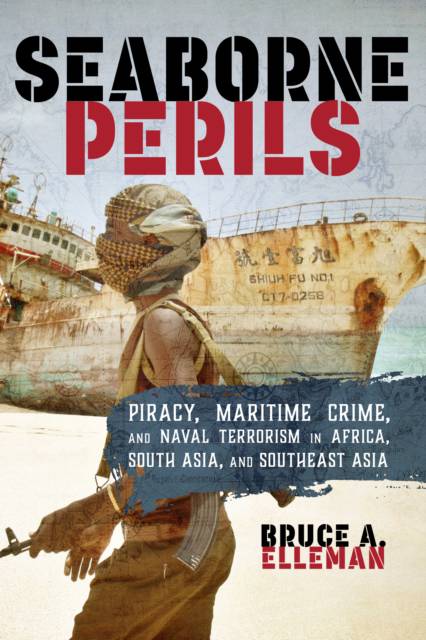
- Retrait gratuit dans votre magasin Club
- 7.000.000 titres dans notre catalogue
- Payer en toute sécurité
- Toujours un magasin près de chez vous
- Retrait gratuit dans votre magasin Club
- 7.000.0000 titres dans notre catalogue
- Payer en toute sécurité
- Toujours un magasin près de chez vous
Seaborne Perils
Piracy, Maritime Crime, and Naval Terrorism in Africa, South Asia, and Southeast Asia
Bruce A Elleman
Livre broché | Anglais
79,95 €
+ 159 points
Format
Description
This comprehensive survey of historical and contemporary issues related to maritime crime and piracy, with a special focus on Africa, South Asia, and Southeast Asia, explains why piracy is a growing problem and how it affects security policy making in the United States.
Here, piracy is defined as taking place on the high seas, while maritime crime takes place within a country's territorial waters. Seaborne terrorism may occur in either one of these maritime zones. Maritime piracy can be divided into several categories, from pirates robbing a ship or its crew of petty items while at sea to taking a ship's cargo and taking control of a vessel, reflagging it, and then using this captured ship to smuggle drugs, transport illegal immigrants, or conduct further acts of piracy. This is the most dangerous, not only because pirates can use a captured ship to carry out more raids, but also because they can use the ship's identity papers to transport goods and weapons--potentially WMDs--into otherwise secure port areas.
A special concern to the US is that the threat of piracy is growing most quickly in parts of the world--such as Africa, South Asia, and Southeast Asia--where both global trade is rapidly expanding and where international terrorist groups are actively functioning or have supporters. This geographical overlap suggests that the risk that pirates and terrorists may one day cooperate to strike at the US or an ally is most likely also on the rise.
While many important African, South Asia, and Southeast Asian cases have received insufficient attention, many well-known historical piracy events stand in need of a reappraisal. This book integrates a number of multinational, multiregional, and historical cases of piracy, maritime crime, and seaborne terrorism to investigate whether piracy and other forms of maritime crime are becoming a major United States national security concern. It analyzes some of the most important cases, especially of the 19th, 20th, and early 21st centuries, as well as specific historical events. This allows to draw lessons as to what are the components of successful and unsuccessful piracy, common causes, the type of navy necessary to control it, and finally, possible military, political, and economic consequences. The book also discusses various types of cases, including parasitic, intrinsic, episodic, and opportunistic piracy. Specific cases are also evaluated in terms of the changing interpretations of international law and the recent reported growth rates of piracy, maritime crime, and seaborne terrorism. These findings are used to explore the impact of piracy on maritime security, in particular in Africa, South Asia, and Southeast Asia and their surrounding waters, which is where the majority of contemporary piracies and maritime crimes occur. Different methods of policing piracy and maritime crime are evaluated, including the viability of adopting greater Maritime Domain Awareness, which would require that all ships at sea--regardless of size or function--emit a signal beacon identifying their name, country of origin, and route. This combination of historical and modern day piracy and the many cases studied will provide readers with a broader understanding of maritime piracy.
Here, piracy is defined as taking place on the high seas, while maritime crime takes place within a country's territorial waters. Seaborne terrorism may occur in either one of these maritime zones. Maritime piracy can be divided into several categories, from pirates robbing a ship or its crew of petty items while at sea to taking a ship's cargo and taking control of a vessel, reflagging it, and then using this captured ship to smuggle drugs, transport illegal immigrants, or conduct further acts of piracy. This is the most dangerous, not only because pirates can use a captured ship to carry out more raids, but also because they can use the ship's identity papers to transport goods and weapons--potentially WMDs--into otherwise secure port areas.
A special concern to the US is that the threat of piracy is growing most quickly in parts of the world--such as Africa, South Asia, and Southeast Asia--where both global trade is rapidly expanding and where international terrorist groups are actively functioning or have supporters. This geographical overlap suggests that the risk that pirates and terrorists may one day cooperate to strike at the US or an ally is most likely also on the rise.
While many important African, South Asia, and Southeast Asian cases have received insufficient attention, many well-known historical piracy events stand in need of a reappraisal. This book integrates a number of multinational, multiregional, and historical cases of piracy, maritime crime, and seaborne terrorism to investigate whether piracy and other forms of maritime crime are becoming a major United States national security concern. It analyzes some of the most important cases, especially of the 19th, 20th, and early 21st centuries, as well as specific historical events. This allows to draw lessons as to what are the components of successful and unsuccessful piracy, common causes, the type of navy necessary to control it, and finally, possible military, political, and economic consequences. The book also discusses various types of cases, including parasitic, intrinsic, episodic, and opportunistic piracy. Specific cases are also evaluated in terms of the changing interpretations of international law and the recent reported growth rates of piracy, maritime crime, and seaborne terrorism. These findings are used to explore the impact of piracy on maritime security, in particular in Africa, South Asia, and Southeast Asia and their surrounding waters, which is where the majority of contemporary piracies and maritime crimes occur. Different methods of policing piracy and maritime crime are evaluated, including the viability of adopting greater Maritime Domain Awareness, which would require that all ships at sea--regardless of size or function--emit a signal beacon identifying their name, country of origin, and route. This combination of historical and modern day piracy and the many cases studied will provide readers with a broader understanding of maritime piracy.
Spécifications
Parties prenantes
- Auteur(s) :
- Editeur:
Contenu
- Nombre de pages :
- 272
- Langue:
- Anglais
Caractéristiques
- EAN:
- 9781442260191
- Date de parution :
- 19-02-18
- Format:
- Livre broché
- Format numérique:
- Trade paperback (VS)
- Dimensions :
- 150 mm x 226 mm
- Poids :
- 362 g

Les avis
Nous publions uniquement les avis qui respectent les conditions requises. Consultez nos conditions pour les avis.






